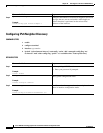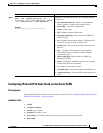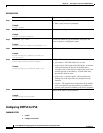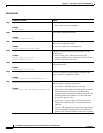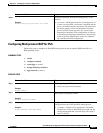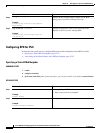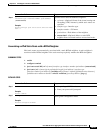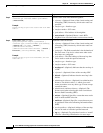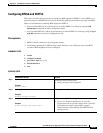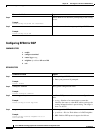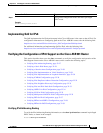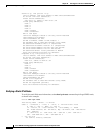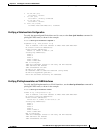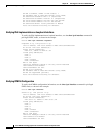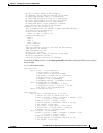
32-24
Cisco ASR 901 Series Aggregation Services Router Software Configuration Guide
OL-23826-09
Chapter32 IPv6 Support on the Cisco ASR 901 Router
How to Configure IPv6 Support on the Cisco ASR 901 Router
Step 3
ipv6 route static bfd [vrf
vrf-name
]
interface-ype interface-number ipv6-address
[unassociated]
Example:
Router(config)# ipv6 route static bfd vlan 4000
2001::1
Specifies static route IPv6 BFDv6 neighbors.
• vrf-name—(Optional) Name of the virtual routing and
forwarding (VRF) instance by which static routes are
specified.
• interface-type—Interface type.
• interface-number—SVI name.
• ipv6-address—IPv6 address of the neighbor.
• unassociated—(Optional) Moves a static BFD
neighbor from associated mode to unassociated mode.
Step 4
ipv6 route [vrf
vrf-name
]
i
pv6-prefix/prefix-length
{
ipv6-address
|
interface-type
[
interface-number ipv6-address
]}
[nexthop-vrf [
vrf-name1
| default]]
[
administrative-distance
]
[
administrative-multicast-distance
| unicast |
multicast] [
next-hop-address
] [tag
tag
]
Example:
Router(config)# ipv6 route 2001:DB8::/64 vlan
4000 2001::1
Establishes static IPv6 routes.
• vrf-name—(Optional) Name of the virtual routing and
forwarding (VRF) instance by which static routes are
specified.
• ipv6-prefix—The IPv6 network that is the destination of
the static route. Can also be a host name when static
host routes are configured.
• ipv6-address—The IPv6 address of the next hop that
can be used to reach the specified network.
• interface-type—Interface type.
• interface-number—SVI name.
• nexthop-vrf—(Optional) Indicator that the next hop is
a VRF.
• vrf-name1—(Optional) Name of the next-hop VRF.
• default—(Optional) Indicator that the next hop is the
default.
• administrative-distance—(Optional) An administrative
distance. The default value is 1, which gives static
routes precedence over any other type of route except
connected routes.
• administrative-multicast-distance—(Optional) The
distance used when selecting this route for multicast
Reverse Path Forwarding (RPF).
• unicast—(Optional) Specifies a route that must not be
used in multicast RPF selection.
• multicast—(Optional) Specifies a route that must not
be populated in the unicast Routing Information Base
(RIB).
• next-hop-address—(Optional) Address of the next hop
that can be used to reach the specified network.
• tag tag—(Optional) Tag value that is used as a “match”
value for controlling redistribution via route maps.
Command or Action Purpose



